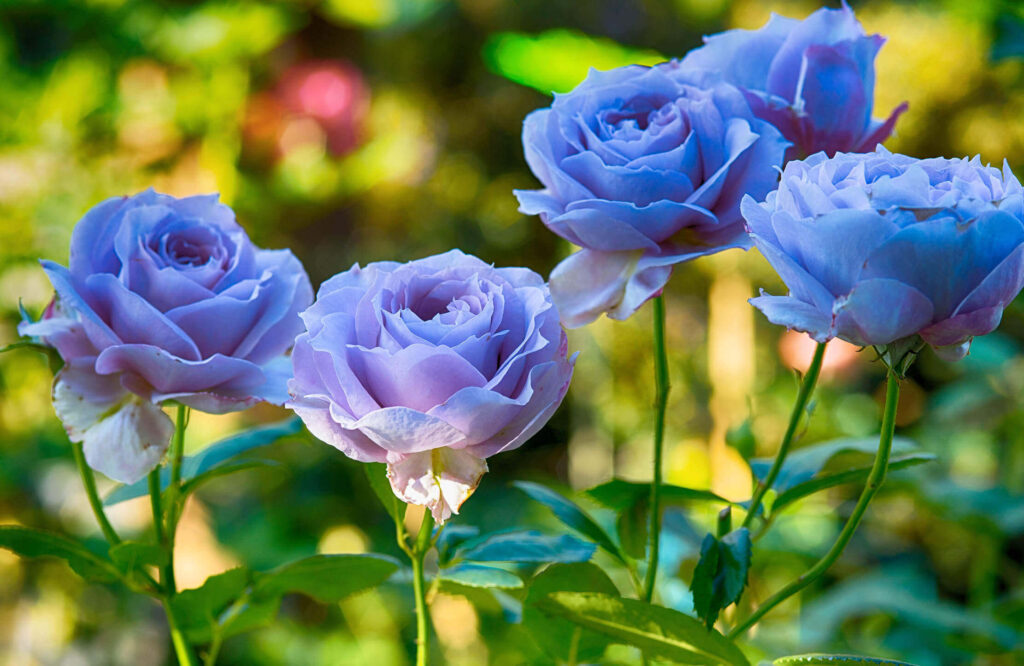Introduction to Blue roses
Blue roses have fascinated people for centuries with their mysterious beauty and rarity. Unlike typical red or pink roses, blue roses carry a sense of wonder, sparking intrigue and admiration in those who behold them. Due to genetic restrictions, namely the lack of the genes required to generate a genuine blue hue, a blue rose is a flower of the genus Rosa that does not normally arise. They have historically been produced by hybridizing or dying white roses; both processes frequently produce hues that are more violet than blue. The blue pigment delphinidin was successfully added to a genetically engineered rose in 2002, although it looked more lavender than blue.
What Are Blue Roses?
At first glance, the idea of a blue rose seems almost mythical. While roses naturally occur in a wide range of colors—red, white, yellow, and pink—the blue rose stands out because it doesn’t exist in nature. Unlike other flowers, roses lack the specific pigment necessary to produce a true blue color. As a result, they are often the product of genetic engineering, hybridization, or artificial dyeing.
Symbolism and Meaning
Blue roses are often seen as symbols of the unattainable and the mysterious. They represent a quest for the impossible, a desire to achieve what seems out of reach. People associate blue rose with feelings of hope, wonder, and fascination. In romantic contexts, they can signify deep, unspoken love or a connection that transcends the ordinary. The ethereal hue gives them an almost otherworldly quality, making them a powerful symbol in both art and life.
History and Evolution of Blue Roses
Origin of Blue Roses in Myth and Culture
The idea of blue roses has been part of human culture for centuries. In many myths and legends, the blue rose is often seen as a symbol of the impossible or the extraordinary. People believed that anyone who found a blue rose would have their greatest wishes granted or would discover a deep secret of life. This idea carried into various cultural stories, giving the blue rose an iconic place in folklore.
The Science Behind Blue Roses: Are They Real?
While blue rose in nature may not exist, the journey to create them through science has been an interesting one. With advances in genetic engineering, botanists have attempted to modify roses to produce a blue hue. This effort has involved inserting genes from other flowers that naturally contain blue pigments, such as petunias and pansies. However, even with modern science, achieving a true blue rose remains difficult, and most “blue” roses that exist today are more of a lavender or purplish hue.
First Successful Creation of Blue Roses
In 2004, Japanese scientists made headlines when they announced the first genetically engineered blue rose. While the rose was not a perfect shade of blue—leaning more toward lavender—it marked a significant breakthrough. This experiment was the closest humanity had come to achieving the dream of a true blue rose.
The Role of Genetic Engineering in Blue Roses
Genetic engineering has played a vital role in bringing the concept of blue rose closer to reality. By altering the genetic makeup of traditional roses, scientists have been able to influence their color pigments. While the dream of a fully blue rose is still ongoing, hybrid versions that mimic blue hues are becoming increasingly popular.
Popular Varieties
Are There Natural Blue Rose Varieties?
Despite countless efforts, no naturally occurring blue rose varieties exist. This limitation is due to the absence of delphinidin, the pigment responsible for creating blue colors in flowers. All blue rose are either artificially created through dyeing or are the product of hybrid flowers bred to have bluish-purple tones.
Artificially Dyed Blue Roses: How Are They Made?
One of the most popular ways to create blue rose is by dyeing white roses. Florists often use special dyes to achieve a rich blue hue. This process involves cutting the stems of white roses and placing them in water mixed with blue dye. The flowers absorb the color, eventually turning their petals a striking blue.
Hybrid Blue Roses: Mixing Colors for Unique Shades
Another approach to achieving blue rose is through hybridization. By cross-breeding roses with various shades of purple and pink, horticulturists have created roses that come close to appearing blue. Though not a perfect blue, these hybrids are often sought after for their unique and enchanting colors.
Most Sought-After Blue Rose Varieties for Gardens
Among the most popular varieties of blue rose for gardens are those that have subtle blue tones. Varieties such as ‘Blue Moon’ and ‘Blue Girl’ are favorites among gardeners for their lavender-blue petals. These varieties offer a sense of mystery and elegance, making them ideal for any garden.
Symbolism of Blue Roses in Different Cultures
Blue Roses in Western Culture: Mystery and Unattainability
In Western culture, they have long been seen as symbols of the mysterious and unattainable. They are often used in literature and art to represent love that cannot be, dreams that remain unfulfilled, or the pursuit of the impossible. Their rarity adds to their mystique, making them a popular motif in works of fiction and poetry.
Blue Roses in Eastern Traditions: Love, Hope, and Immortality
In Eastern cultures, the blue rose takes on a different meaning. It is often associated with immortality, representing the eternal nature of love or the soul. In some Asian traditions, they symbolize hope, new beginnings, and overcoming the impossible. They are seen as flowers of positivity and transformation.
The Role of Blue Roses in Literature and Art
From ancient myths to modern novels, they have captured the imaginations of writers and artists alike. Their symbolic nature has made them a popular subject in many forms of creative expression. In literature, they often symbolize elusive love or unattainable beauty, while in visual arts, they are used to evoke feelings of mystery and wonder.
How to Grow and Care for Blue Roses
Can You Grow Blue Roses in Your Garden?
Growing blue rose in your garden is possible, though it often involves purchasing dyed or hybrid varieties rather than true blue rose. While you can’t cultivate a true blue rose from seeds, there are plenty of hybrid and dyed options available for gardeners who want to add a splash of blue to their floral arrangements.
Best Climate and Conditions for Blue Roses
They, like other rose varieties, thrive in sunny climates with well-drained soil. They prefer areas that receive at least six hours of direct sunlight per day and do well in temperate environments. When planting blue rose, it’s essential to ensure they receive proper care, including regular watering, fertilizing, and pruning.
Step-by-Step Guide to Growing Blue Roses from Seeds
- Choose the Right Variety: Since blue rose don’t exist naturally, opt for a hybrid variety like ‘Blue Moon.’
- Planting Time: The best time to plant rose seeds is in early spring.
- Soil Preparation: Use well-drained, loamy soil mixed with organic matter.
- Watering: Water regularly, keeping the soil moist but not waterlogged.
- Fertilizing: Apply a balanced rose fertilizer once a month.
- Pruning: Regularly prune your blue rose bush to promote healthy growth.
Common Challenges When Growing Blue Roses and How to Solve Them
Growing roses, including blue varieties, can come with its challenges. Common issues include pests like aphids and fungal diseases such as black spot or mildew. Regular inspection, using insecticidal soap, and proper spacing to ensure good air circulation can help manage these problems effectively.
Where to Buy Blue Roses
Best Online Stores to Purchase Blue Roses
If you’re looking to buy blue rose, many reputable online stores specialize in dyed and hybrid varieties. Websites like ProFlowers, 1-800-Flowers, and Global Rose offer a wide selection of blue roses for various occasions.
What to Consider When Buying Blue Roses: Fresh vs. Artificial
When purchasing blue rose, you’ll need to decide between fresh and artificial options. Fresh blue roses are often dyed, while artificial roses may be made from silk or other materials. Fresh roses provide a vibrant, natural look but have a limited lifespan. Artificial roses, on the other hand, last longer and can be used as permanent decorative pieces.
Top Nurseries That Specialize in Blue Roses
Several nurseries specialize in selling hybrid blue rose varieties. These include Jackson & Perkins, David Austin Roses, and Heirloom Roses, where you can find unique shades of lavender-blue rose that closely resemble the elusive blue rose.
Creative Uses of Blue Roses
In Weddings: Ideas and Arrangements
They are becoming increasingly popular in weddings. Their unique color offers a fresh take on traditional floral arrangements. They can be used in bridal bouquets, centerpieces, and even floral arches. Pairing blue rose with white flowers like lilies or baby’s breath can create a stunning contrast.
Gifts: When and Why to Give Them?
They make for meaningful and thoughtful gifts. Because they symbolize mystery, hope, and the impossible, they’re often given to express admiration, deep love, or gratitude. They are ideal for special occasions like anniversaries, romantic gestures, or as a gift for someone going through a life transition.
Home Décor: Arrangements and Styling Tips
Incorporating blue rose into your home décor can add a touch of elegance and mystery to any room. Whether fresh or artificial, they can be arranged in vases, wall hangings, or even wreaths to bring a sense of tranquility and beauty to your living space.
Blue Roses in Bouquets: How to Pair Them with Other Flowers
When creating bouquets with blue roses, it’s important to pair them with complementary flowers. White, pink, or yellow flowers can enhance the beauty of blue rose, creating a vibrant and balanced arrangement. Greenery, such as eucalyptus or ferns, also works well to frame the striking blue petals.
Conclusion
Blue roses captivate the imagination with their rich symbolism and striking appearance. Whether used in weddings, gifted to a loved one, or grown in your own garden, they offer a unique way to express feelings of wonder, hope, and the impossible. Though they may not exist naturally, their allure continues to enchant us. With advances in science and creative floral techniques, they have become a reality that you can enjoy in many forms.
Also Read: https// gamemakerblog.net: Game Development Knowledge
FAQs
Are Blue Roses Real?
No, blue rose do not exist naturally. They are often created through artificial dyeing or genetic modification.
What Do Blue Roses Symbolize?
Blue rose symbolize mystery, the unattainable, and deep, hidden emotions. They are also associated with hope and new beginnings.
Can I Grow Blue Roses at Home?
Yes, while true blue rose cannot be grown, hybrid or dyed varieties can be cultivated in home gardens.
What Are the Best Blue Rose Varieties for Beginners?
For beginners, varieties like ‘Blue Moon’ or ‘Blue Girl’ are great options, as they offer blueish hues with relatively easy care.
Where Can I Buy Blue Roses Online?
Online retailers like 1-800-Flowers and ProFlowers offer blue rose for purchase.
How Long Do Blue Roses Last?
Fresh blue rose typically last between 7 to 10 days, while artificial blue roses can last for years.







